Fully Automatic Electrolyte Analyzers Market Research, 2032
The global fully automatic electrolyte analyzers market size was valued at $439.7 million in 2022, and is projected to reach $766.5 million by 2032, growing at a CAGR of 5.7% from 2023 to 2032. Electrolyte concentration in the blood, plasma, and other body fluids are measured by using the fully automatic electrolyte analyzer. The electrically charged ions that are called electrolytes are essential for maintaining a variety of body functions, such as fluid balance, nerve impulse transmission, and muscle contraction and relaxation. These analyzers work on a principle of ion-selective electrodes, which selectively detect specific ions and generate an electrical signal proportional to their concentration.
Fully automatic electrolyte analyzers are designed to streamline the testing process and reduce human error. They often feature an automated sample handling system, allowing for efficient sample loading and analysis without the need for manual intervention. The analyzers can handle multiple samples simultaneously, enabling high throughput in clinical laboratories.
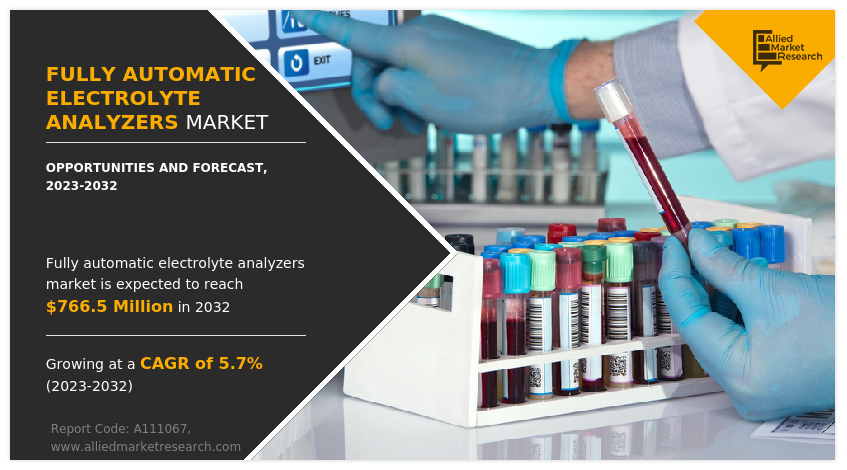
Market Dynamics
The fully automatic electrolyte analyzers market size is driven by increase in prevalence of long-term diseases such as diabetes, cardiovascular diseases, and others and rise in awareness about the advantages of preventive healthcare. Diabetes is a long-term condition in which blood glucose levels are high. The high blood glucose levels lead to electrolyte imbalances due to excessive urination, and cause loss of electrolytes such as sodium, potassium, and others through urine.
For instance, according to the National Center for Biotechnology Information (NCBI), in 2023, the prevalence of electrolyte imbalance among diabetic patients was 83.07%. In addition, according to the German Centers for Health Research (DZG), about 8.5 million people suffer from diabetes in Germany and about 2 million people are living with undiagnosed diabetes. Therefore, close monitoring of electrolyte levels in diabetic patients is essential which, in turn, increase the demand for fully automatic electrolyte analyzers and contribute to the fully automatic electrolyte analyzers market share.
Furthermore, increase in the number of individuals those are taking preventive measures to monitor health and prevent the risk of chronic diseases is driving the demand for fully automatic electrolyte analyzers. Fully automatic electrolyte analyzers are employed for the routine check-ups in healthcare facilities as well as in homecare settings. In addition, rise in government initiatives and healthcare spending further contribute toward the market growth. For instance, the preventive healthcare expenditure in European Union (EU) was about 0.37% of the total GDP in 2020.
In addition, advancements in the electrolyte analyzers technology are the key factors that drive the market growth. For instance, newly launched Sensacore's ST-200 CC Ultra Smart ABGEM blood gas analyzer is a highly advanced and completely automated microprocessor-controlled electrolyte system. It is based on the principle of direct measurement with ion selective electrode (ISE), Impedance (Hct), and Amperometry (pO2) technology to make arterial blood gas analysis and electrolyte measurements. It is an integrated system that measures various electrolytes and their combinations such as sodium, potassium, lithium, calcium, chloride, and others. This system is specifically designed to process a large number of samples, which improves lab productivity.
In addition, SG1 Blood Gas & Electrolyte Analyzer offered by Chengdu Seamaty Technology Co., Ltd., is an easy-to-use handheld portable analyzer that provides accurate electrolyte, blood gas, and critical care biochemistry results within few minutes. It is an easy-to-use device with advanced technologies of ion selective electrode.
In addition, increase in product approvals by regulatory authorities also drives the growth of the market. Approved drugs are marketed and sold to healthcare providers, which expand their accessibility to patients. This market expansion leads to increased revenue generation, which, in turn, supports the fully automatic electrolyte analyzers market growth.
The growth of the fully automatic electrolyte analyzers market is expected to be driven by surge in the number of patients being treated in intensive care units (ICUs) and emergency departments. According to Fraser Health, the common reasons a patient may need Intensive Care Unit (ICU), are shock, wherein, the body organs do not get enough oxygen for normal body function, acute respiratory failure, chronic respiratory failure, renal failure, neurological conditions, bleeding, and clotting, multi organ dysfunction syndrome and injury.
For instance, according to research article published by Science Direct in 2023, more than 5.7 million people are admitted to intensive care units (ICUs) every year in the U.S. With the rise in the number of patients admitted in ICUs, and emergency departments, there is an increase in the demand for the use of electrolyte analyzers to rapidly diagnose the cause of illness and help treat the patients in critical care.
Moreover, rise in ageing population and increase in incidence & prevalence of chronic diseases are expected to fuel the demand for fully automatic electrolyte analyzers globally which contribute to the fully automatic electrolyte analyzers market share.
However, high cost of fully automatic electrolyte analyzers, limited access in low-income countries, and reliance on traditional methods restrain the growth of the fully automatic electrolyte analyzers market. High costs of fully automatic electrolyte analyzers may create barriers that restrict their adoption in smaller healthcare facilities. Thus, limited access to costly fully automatic electrolyte analyzers hampers the market growth. Furthermore, lack of proper infrastructure, including stable power supply, trained personnel, and maintenance support, can restrict the widespread adoption and usage of these analyzers in such settings.
On the other hand, fully automatic electrolyte analyzers offer the advantage of real-time results at the point of care, enabling immediate decision-making and timely interventions. Thus, rise in adoption of POCT in various healthcare settings are expected to create lucrative opportunities for the growth of fully automatic electrolyte analyzers market during the forecast period.
Segmental Overview
The fully automatic electrolyte analyzers market is segmented on the basis of type, modality, end user, and region. On the basis of type, the market is classified into standalone and integrated. On the basis of modality, the market is bifurcated into benchtop and portable. As per end user, the market is divided into hospitals, diagnostic centers, and others. Others segment includes clinics, homecare settings, and ambulatory surgical centers. Region wise, the fully automatic electrolyte analyzers industry is analyzed across North America (the U.S., Canada, and Mexico), Europe (Germany, France, the UK, Italy, Spain, and rest of Europe), Asia-Pacific (China, Japan, Australia, India, South Korea, and rest of Asia-Pacific), and LAMEA (Brazil, South Africa, Saudi Arabia, and rest of LAMEA).
By Type
The fully automatic electrolyte analyzers market is segmented into integrated and standalone. The integrated segment dominated the global market in 2022 and is expected to remain dominant throughout the forecast period as they can perform multiple tests simultaneously, including blood gas analysis, pH measurement, and ionized calcium measurement. In addition, the integrated analyzers offer a user-friendly interface and intuitive operation. Healthcare professionals can easily navigate through different tests and functions on a single platform and improve overall user experience.
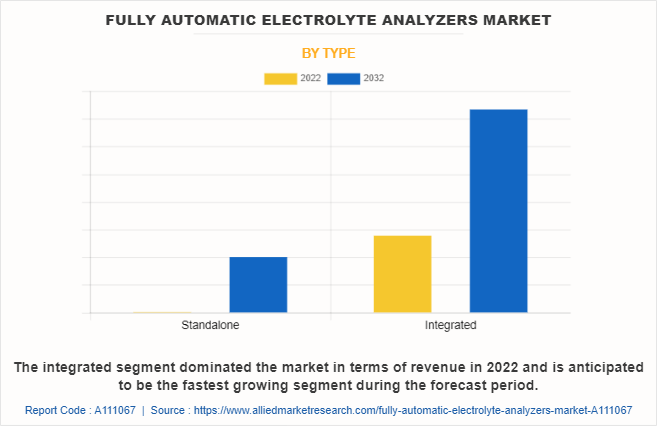
By Modality
The fully automatic electrolyte analyzers market is segregated into portable and benchtop. The benchtop segment dominated the global market in 2022 and is anticipated to continue this trend during the forecast period. This is attributed to lower initial cost as compared to larger high-volume analyzers. In addition, technological advancements in benchtop fully automatic analyzers such as automated sample handling, intuitive interfaces, connectivity options, and improved analytical accuracy further drives the demand for benchtop analyzers. On the other hand, portable is the fastest growing segment during the forecast period owing to, surge in demand for point-of-care testing. In addition, portable analyzers enhance accessibility to diagnostic testing and support preventive care initiatives.
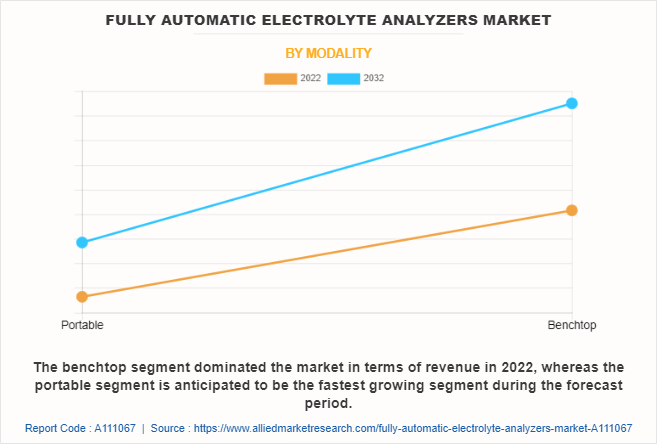
By End User
The fully automatic electrolyte analyzers market is segmented into hospitals, diagnostic centers, and others. The diagnostic centers segment dominated the global market in 2022. This is attributed to high adoption of benchtop analyzers in the diagnostic centers. On the other hand, hospitals are expected to be the fastest growing segment during the forecast period. This is attributed to high testing volumes, diverse patient populations, and the need for rapid and accurate electrolyte measurements. In addition, the centralized testing facilities, and comprehensive testing capabilities beyond electrolyte analysis further increases the adoption of fully automatic electrolyte analyzers in the hospital settings.
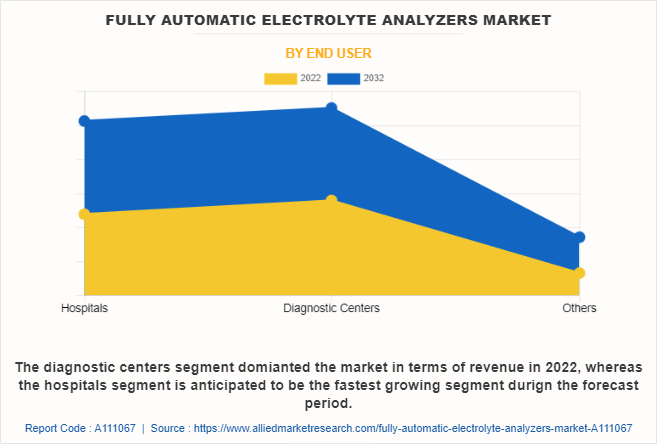
By Region
The fully automatic electrolyte analyzers market is analyzed across North America, Europe, Asia-Pacific, and LAMEA. North America accounted for a major share of the market in 2022 and is expected to maintain its dominance during the forecast period.
The presence of several major players, such as Abbott Laboratories, Siemens AG, and F. Hoffmann-La Roche Ltd. and the rise in prevalence of various chronic diseases in the region drive the growth of the fully automatic electrolyte analyzers industry. For instance, according to the National Diabetes Statistics Report 2020 provided by Centers for Disease Control and Prevention (CDC), about 34.2 million people (10.5%) U.S. population has diabetes.
Increase in prevalence of diabetes leads to greater demand for fully automatic electrolyte analyzers, which drives the market growth. In addition, adoption of technologically advanced integrated as well as standalone fully automatic electrolyte analyzers further boosts the market growth in this region. Moreover, availability of fully automatic electrolyte analyzers boosts the growth of the market.
Asia-Pacific is expected to witness growth at the highest rate during the forecast period. The market growth in this region is attributable to the increase in demand for fully automatic electrolyte analyzers in this region. Asia-Pacific region has a large population, and there has been an observed increase in the prevalence of chronic diseases in recent years due to ageing population, lifestyle changes, and environmental factors. This has led to an increase in the number of patients undergoing diagnostic testing, which in turn increases the demand for fully automatic electrolyte analyzers. In addition, growing adoption of fully automatic electrolyte analyzers further propels the market growth.
Asia-Pacific offers profitable opportunities for key players operating in the market, thereby registering the fastest growth rate during the fully automatic electrolyte analyzers market forecast period, owing to the rise in disposable income, as well as increase in healthcare expenditure.
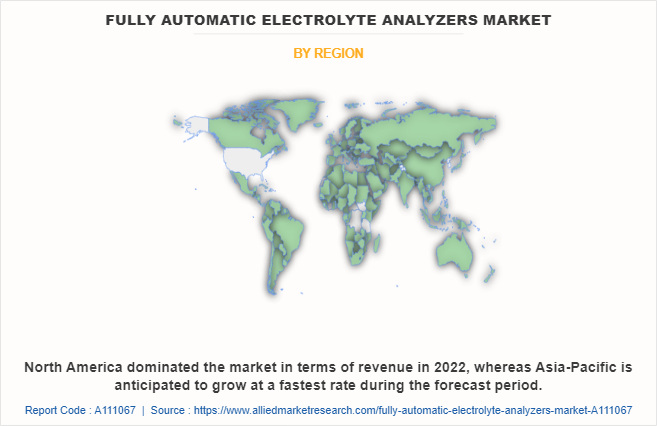
Competition Analysis
Competition analysis and profiles of the major players in the fully automatic electrolyte analyzers, such as Accurex Biomedical Pvt. Ltd., Medica Corporation, F. Hoffmann-La Roche Ltd., Abbott Laboratories, Caretium Medical Instruments Co., Diamond Diagnostics, Neomedica, Agappe Diagnostics Ltd, Siemens AG, and HD Consortium India Limited. Other key players in the market include Sensa Core, Chengdu Seamaty Technology Co., Ltd., and others. Major players have adopted product launch as a key developmental strategy to improve the product portfolio and gain strong foothold in the fully automatic electrolyte analyzers market.
Recent Product Launch in the Fully Automatic Electrolyte Analyzers Market
In September 2021, Sensa Core, a medical instrumentation company, launched its new completely automatic ST-200CC Blood Gas Analyzers- Ultra Smart for clinics, diagnostic centers, and hospitals. It is an integrated system that measures electrolytes as well as blood gases.
Key Benefits for Stakeholders
- This report provides a quantitative analysis of the market segments, current trends, estimations, and dynamics of the fully automatic electrolyte analyzers market analysis from 2022 to 2032 to identify the prevailing fully automatic electrolyte analyzers market opportunity.
- The market research is offered along with information related to key drivers, restraints, and opportunities.
- Porter's five forces analysis highlights the potency of buyers and suppliers to enable stakeholders make profit-oriented business decisions and strengthen their supplier-buyer network.
- In-depth analysis of the fully automatic electrolyte analyzers market segmentation assists to determine the prevailing market opportunities.
- Major countries in each region are mapped according to their revenue contribution to the global market.
- Market player positioning facilitates benchmarking and provides a clear understanding of the present position of the market players.
- The report includes the analysis of the regional as well as global fully automatic electrolyte analyzers market trends, key players, market segments, application areas, and market growth strategies.
Fully Automatic Electrolyte Analyzers Market Report Highlights
| Aspects | Details |
| Market Size By 2032 | USD 766.5 million |
| Growth Rate | CAGR of 5.7% |
| Forecast period | 2022 - 2032 |
| Report Pages | 236 |
| By Type |
|
| By Modality |
|
| By End User |
|
| By Region |
|
| Key Market Players | Diamond Diagnostics, Caretium Medical Instruments Co., Accurex Biomedical Pvt. Ltd., Agappe Diagnostics Ltd, Siemens AG, Abbott Laboratories, HD Consortium India Limited, F. Hoffmann-La Roche Ltd., Neomedica, Medica Corporation |
Analyst Review
The growth of the global fully automatic electrolyte analyzers is attributed to factors such as rise in demand for automatic electrolyte analyzers due to increase in prevalence of chronic diseases such as diabetes, hypertension, renal diseases, and others.
In addiiton, advancements in fully automatic electrolyte analyzer technologies such as advanced sensing electrodes, automatic calibration, and accurate electrolyte measurements making it an essential tool in clinical decision-making. In addition, surge in demand for point-of-care testing also drives the demand for portable electrolyte analyzers, which further boosts the market growth. However, high cost of the automatic electrolyte analyzers as compared to semi-automated electrolyte analyzers restrain the growth of the market.
Furthermore, North America witnessed the highest growth in 2022, in terms of revenue, owing to surge in chronic diseased population and increase in diagnostic testing. However, Asia-Pacific is expected to exhibit the fastest growth during the forecast period owing to, owing to the presence of domestic manufacturers of automatic electrolyte analyzers, development of healthcare settings, and surge in prevalence of chronic diseases
The base year is 2022 in fully automatic electrolyte analyzers market.
The forecast period for fully automatic electrolyte analyzers market is 2023 to 2032.
The total market value of fully automatic electrolyte analyzers market is $439.7 million in 2022.
The market value of fully automatic electrolyte analyzers market in 2032 is $766.5 billion.
Major players that operate in the fully automatic electrolyte analyzers market are Accurex Biomedical Pvt. Ltd., Medica Corporation, F. Hoffmann-La Roche Ltd., Abbott Laboratories, Caretium Medical Instruments Co., Diamond Diagnostics, Neomedica, Agappe Diagnostics Ltd, Siemens AG, and HD Consortium India Limited.
The intergrated segment is the most influencing segment in the market owing to the surge in demand for integrated analyzers for testing of multiple variables at a same time.
Key factors driving the growth of the fully automatic electrolyte analyzers market includes increase in need for modern healthcare technology, rise in trend towards decentralized medical care, and surge in prevalence of long-term illnesses such as diabetes, coronary artery disease, and hypertension.
Asia-Pacific has the highest growth rate with a CAGR of 6.5% owing owing to major presence of domestic players, development of healthcare systems, surge in chronic disease population, and development in medical device industry.
Loading Table Of Content...
Loading Research Methodology...



